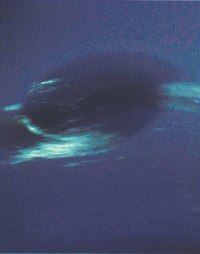Jupiter is not the only gas giant with unique atmospheric formations. The laptop also has a big stain
When Voyager 2 arrived at the planet Neptune, space scientists were in for a series of surprises. One of the surprises was that Neptune has a very large dark spot in the southern hemisphere. It is an elliptical configuration whose long axis is 15,000 km long, and whose short axis is 7,000 km long. An order of magnitude reminiscent of Jupiter's red spot, albeit smaller. For comparison, the diameter of the Earth's sphere is 12,750 km, which means that its long axis is greater than the diameter of the Earth.
Compared to Jupiter's red spot, its rate of movement through the atmosphere is very fast. If the red spot moves at a speed of 10.8 km/h, Neptune's spot moves at a speed of 1080 km/h. A figure that can testify to the speed of its movement is a comparison with the axial speed of Neptune. Neptune rotates around its axis once every 16.11 hours and the spot orbits it once every 18.3 hours. The direction of its movement is counterclockwise. The color of the spot is blue like its surroundings but with greater intensity. This is not a normal movement. The spot rotates around itself in the direction of its movement and every 10-11 laps of Neptune the long axis turns east-west and it stretches and contracts during its movement like a pulse. In the observations with the Hubble telescope aimed at it in June 1994, it was no longer observed and in contrast a new spot was discovered that developed in the northern hemisphere.
The accepted estimate is that the spot is a high-pressure anticyclonic system rotating around its center. is that so? Compared to the red spot of Jupiter and another spot of Neptune, no eddy movements were observed on its surface. From the fact that in almost regular cycles it turns its long axis towards east-west, and still maintains its elliptical configuration, a conclusion is required that it has another axis, which means that the spot has a spatial shape. This is a new phenomenon and it is that the spot is actually a bubble that surrounds Neptune in its atmosphere. If it is indeed a bubble, several conclusions are required from this and they are:
1. From the fact that the bubble has not been seen since 1994, one gets the impression that its life span is very short compared to the life span of Jupiter's red spot which has been observed for 350 years.
2. It may be that the movement of the bubble around its axis while moving around Neptune, accompanies it from its formation until its disappearance.
3. The pulsations of the bubble occur while it is moving. A possible explanation for this is that there is some kind of mechanism that supplies the bubble with air and removes it from it in a cyclical manner. When the air supply decreases the bubble shrinks and when the air supply increases the bubble expands.
4. Another question that arises is what caused the bubble to disappear. Such a phenomenon can occur in two situations. One situation where the bubble rises to a height where the air pressure inside it is higher than the pressure outside and it explodes. The second situation is when the bubble descends until it reaches a point where the surrounding pressure is greater than the air pressure inside it and then it is crushed. In any case, shock waves are created as a response to the event. In the first case the intensity of the shock waves will be greater and they will spread to greater distances than in the second case. If it is indeed the first case that occurred, then it is possible to check this by comparing all the photographs from the time the stain disappeared and check if there are any signs
for large and rapid changes in the atmosphere. The second case cannot be verified since the event took place deep within the atmosphere.
The obvious fundamental question is what even leads to the formation of this bubble. A possible way to deal with this phenomenon is to try to create a computer model that creates atmospheric bubbles and see what happens.
Sources:
1. Nicolson L. – Focus Neptune Astronomy Now, 9. 1996, p. 38
2. Smith A. et al – Voyager 2 at Neptune: Imaging Results Science, Vol. 246, p. 1422-1449.
https://www.hayadan.org.il/BuildaGate4/general2/data_card.php?Cat=~~~328037224~~~98&SiteName=hayadan

